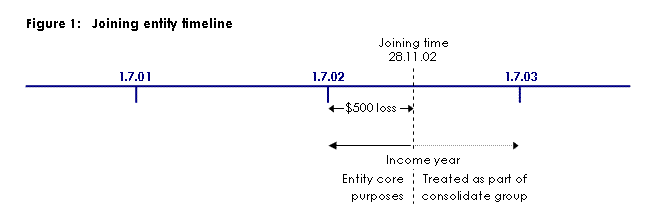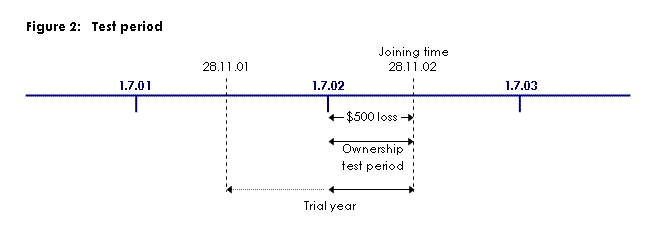Consolidation Reference Manual
You can still refer to the Consolidation reference manual for consolidation information that has not been impacted by changes in the legislation.
C3 Losses
C3-3 Worked example - loss transfer
Transfer testing
C3-3-210 Transfer testing where no ownership or control failure - single joining time and joining year loss case
Description
This example shows how the relevant recoupment test (modified as required) is applied in a situation where an entity incurs a loss in the year it joins a consolidated group.
Commentary
An entity that joins a consolidated group transfers any unutilised losses on hand at the joining time to the head company. It is necessary to apply the relevant recoupment test (modified as required) to ascertain the basis on which a loss is transferred to a head company.
Section 707-120 requires a loss to be tested as if the joining entity was in a position to utilise the loss itself in the context of the trial year and had sufficient income or gains to do so. To the extent that the loss could be so utilised, it is transferred as at the joining time.
Example
Facts
A subsidiary member of a group that consolidates on 28 November 2002 has calculated that it has a loss of $500 for the period 1 July 2002 to 27 November 2002.

Although the income year of the joining entity is 1 July 2002 to 30 June 2003, its core purposes are calculated for the non-membership period that ends before the joining time, that is, 1 July 2002 to 27 November 2002. Refer to Division 701 for the application of the core rules.
Calculation
Step 1: Identify the loss
A loss amount of $500 is identified at the joining time. In working out its core purposes - as required by Division 701 - the joining entity determines that it has in fact incurred a loss for the period 1 July 2002 to 27 November 2002 in the joining year.
The joining entity has a loss as at the joining time.
Step 2: Income year
As the loss is incurred for the 2003 income year (albeit calculated in reference to the non-membership period), the end of the income year (30 June 2003) does not predate the joining time of 28 November 2002. Thus, the joining entity's loss does not satisfy the requirement in paragraph 707-115(1)(b) that it be a loss in respect of an income year that ends before the joining time.
Accordingly, it is not subject to Subdivision 707-A unless a modified rule is applied.
As a loss has been identified in respect of part of an income year, subsection 701-30(8) must be relied on. It provides that a non-membership period loss made by an entity is, for the purpose of Division 707, taken to be a loss made by the entity for an income year that matches the length of the non-membership period. The result is to, in effect, shorten the income year to the period 1 July 2002 to 27 November 2002. The loss is now considered to be a tax loss in respect of an income year that ends before the joining time.
Step 3: Establish the unutilised amount of the loss as at the joining time
Paragraph 707-110(2)(a) states how a tax loss is 'utilised'.
As the tax loss is the net result of calculating its taxable income for the 2003 income year, the joining entity has the full $500 of the loss on hand as at the joining time.
Thus, the full $500 tax loss of the joining entity made in the 2003 income year is subject to the transfer testing process.
Step 4: Apply the ownership and control transfer tests
Sections 165-12 and 165-15 require the company to test for same owners and same control respectively throughout the ownership test period: from the start of the loss year to the end of the income year. In this case:
- •
- the loss year is 1 July 2002 to 27 November 2002, and
- •
- the income year is represented by the trial year 28 November 2001 to just after 28 November 2002.
Even though the trial year begins before the loss year, testing applies only to the period commencing with the start of the loss year to just after the joining time. In this case, testing for an ownership or control failure within the ownership test period is in respect of the period 1 July 2002 to just after 28 November 2002.

Outcome
If the testing process concludes that there is no ownership or control failure over the relevant test period, the loss is transferred to the head company.
If the test is not met, the alternative same business test will be necessary to work out whether it will be transferred at all.
If it cannot be transferred, its utilisation will be restricted in accordance with section 707-150 - that is, it cannot be used by any entity for the 2003 and later income years.
References
Income Tax Assessment Act 1997 , sections 165-12 , 165-15
Income Tax Assessment Act 1997 - as amended by New Business Tax System (Consolidation) Act (No. 1) 2002 (No. 68 of 2002), Schedule 1:
Explanatory Memorandum to the New Business Tax System (Consolidation) Bill (No. 1) 2002, Chapter 6
Income Tax Assessment Act 1997 , subsection 701-30(8) ; as amended by New Business Tax System (Consolidation and Other Measures) Act 2003 (No. 16 of 2003), Schedule 19
Explanatory Memorandum to the New Business Tax System (Consolidation and Other Measures) Bill (No. 2) 2002, Chapter 6
Current at 28 May 2003
